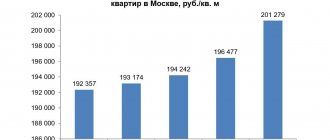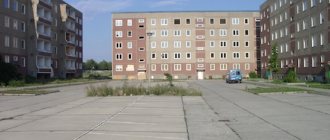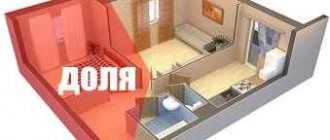Types of ownership of real estate
Before proceeding to counting votes at the OSS, it is necessary to determine the types of ownership of premises in the apartment building. Since the correct counting of votes at the general meeting depends on the type of ownership of real estate.
For example, if there is not one, but several owners in an apartment, then each of them will have the right to vote in proportion to the share in the common property right. Therefore, if from some apartment only one owner out of two or three shareholders was present at the OSS, then his vote cannot be counted for all the owners of this apartment if he does not have a power of attorney from these owners. Because of this, often if votes are counted incorrectly, a quorum may or may not be reached, which can subsequently be challenged in court. In this case, the meeting will be declared invalid.
GIS housing and communal services and absentee voting
221842
Real estate can belong to owners on the basis of joint and common shared ownership .
According to Article 244 of the Civil Code of the Russian Federation, property owned by two or more persons belongs to them under the right of common ownership. Common ownership of property is recognized as shared ownership, unless the law provides for the formation of joint ownership of this property.
In accordance with clause 1 of Article 245 of the Civil Code of the Russian Federation, the shares of participants in the right of common ownership of real estate can be determined by their agreement or on the basis of law. If the size of the shares cannot be determined by the listed methods, then they are recognized as equal.
It is interesting that the Civil Code of the Russian Federation does not specify in what terms the size of shares in the right of common ownership of real estate is determined. However, from the precedents of law enforcement practice, a point of view emerges that allows the shares of participants in common shared ownership of real estate to be expressed both in fractions and as percentages (Resolution of the Federal Antimonopoly Service of the Moscow District dated 03/07/2003 No. KG-A40/944-03).
A similar judgment is contained in clause 5.18 of the Procedure for filling out the form “Information on the inventory value of real estate and other information necessary for calculating taxes” (Order of the Federal Tax Service dated February 11, 2011 No. ММВ-7-11 / [email protected] ).
The right of ownership and other real rights to real estate (restriction, emergence, transition and termination) are subject to state registration in the Unified State Register of Authorities by the bodies that carry out state registration of rights to real estate and transactions with it (Article 131 of the Civil Code of the Russian Federation).
In accordance with the Rules for maintaining the Unified State Register, the size of the share in the right of common ownership must be indicated (Order of the Ministry of Economic Development No. 765 of December 23, 2003). This rule specifies the indication of the size of the share in the form of a regular simple fraction.
Based on this rule, some courts overturn decisions of lower judicial bodies, in which the size of the share in the right to real estate is indicated as a percentage (resolution of the Fourth Arbitration Court of Appeal dated September 16, 2011 No. 04AP-3334/07).
As can be seen from the examples above, indicating in the contract the size of the share in the right of common ownership in the form of interest sometimes leads to legal disputes. Therefore, it is more expedient to indicate in the exchange agreement the size of the shares of participants in common shared ownership in the form of proper fractions.
At the beginning of 2020, Rosreestr will post information in the Housing and Communal Services GIS from the State Real Estate Cadastre and the Unified State Register
125500
There is also joint common ownership in the right of common ownership of real estate, when several people together and at their own discretion can use and dispose of the property that belongs to them on a trust basis. As a rule, joint ownership of real estate arises among spouses (Article 256 of the Civil Code of the Russian Federation) if it was acquired during marriage.
There is another option for joint ownership of real estate, which arises when living space is privatized by people living together, regardless of their family ties. The privatization agreement form contains a column that allows owners to determine what kind of ownership they want to transfer their property into: joint or shared.
How to correctly draw up the minutes of a general meeting
Having considered the meaning of the word quorum, it is necessary to move on to a conversation about the rules for drawing up the minutes of the general meeting. Current laws allow the preparation of both a detailed and a short protocol, which records information about the issues on the agenda. The short minutes reflect only information about the persons who spoke at the meeting, but the full version of the document contains detailed information about all speeches. Each organization has the right to independently choose the type of document. As a rule, such a decision is made by the event manager or agreed upon by all participants.
When taking minutes, you must adhere to the rules of office work. This type of document must be drawn up taking into account current state standards. Any deviation from the established rules may cause the document to lose its legal force.
When drawing up the protocol, you must indicate the full name of the company. The abbreviation is indicated only after the full name. In addition, it is necessary to make a note about the legal form of the company. All of the above data is taken from the company’s constituent documents. It is important to note that indicating an abbreviation instead of the full name of a legal entity is a grave mistake. When preparing the title of the protocol, you must indicate the type of meeting or the name of the body conducting the event. In the header of the document you must indicate:
- Meeting type.
- Place and time of the event.
- Form.
The type of event deserves special attention. In this column you can indicate an annual meeting, a scheduled meeting, or an extraordinary event. Specifying any other type of meeting is not a mistake. Current laws state that scheduled meetings must be held at least once during the year. In the next section it is necessary to record the form of negotiations. In some cases, company members are allowed to participate in meetings in absentia. In the next part of the document a note is made indicating the address of the meeting.
Finally, a list of persons who are required to sign the protocol is drawn up. In order to avoid possible mistakes when drawing up the document in question, it is necessary to carefully study the current regulations. Otherwise, control authorities will consider the document as an act that has no legal force.
How to count the votes of owners on the OSS
The counting of votes of owners at the OSS, as we wrote above, depends on the type of ownership of real estate. Let's consider the counting of votes at a general meeting when voting among participants in common joint and shared ownership.
Instructions for conducting OSS in the form of in-person and absentee voting
1061688
Voting procedure
The procedure for making a decision by the OCC within the scope of authority. Photo No. 3
After we have understood the essence of the general meeting of residents of the house, we can study in more detail the procedural side of voting at such meetings.
In the legislation of the Russian Federation, the voting procedure is considered in sufficient detail, but it can not be understood by every citizen of our country, since the interpretation of all concepts is carried out in a “legal language” that is incomprehensible to the average person.
In fact, the essence and general principles of voting at the OSS are extremely simple and easy to understand. To make it easier to understand the meeting procedure, we will provide the following information:
- Firstly, a meeting of residents can be carried out in three forms:
- in-person gathering, that is, a meeting in the direct presence of all residents of the apartment building;
- absentee collection, that is, a meeting at which decisions are made in writing by each resident of the apartment building;
- in-person collection, that is, a meeting at which decisions are made in the manner of both in-person and absentee collection.
All types of OSS are absolutely legal and competent. The main thing is that during their implementation the basic norms of this procedure are observed.
- Secondly, when organizing a meeting and subsequent voting, it is important to maintain a quorum, that is, a certain number of residents taking part in the meeting and directly voting. According to current laws, the quorum at the OSS is determined by the area of housing. In accordance with the Housing Code of the Russian Federation, a quorum is considered to be met if the owners of more than 50% of the residential area of the apartment building are present at the meeting. Otherwise, it is impossible to conduct the OSS and, accordingly, voting.
Maintaining OSS protocol. Photo No. 4
- Thirdly, the person who initiates the organization of the meeting undertakes to notify all residents of the apartment building about the upcoming event at least 10 days before it takes place. Notification of the OSS must be in writing by registered mail. A meeting can be initiated by:
- any resident of an apartment building;
- Management Company;
- members and authorized persons of the homeowners association.
- Fourthly, before voting it is necessary to draw up a special register containing the following information:
- Full name of the owner of each apartment who is present at the meeting or there is a representative instead;
- footage of the apartment of each tenant participating in the OSS.
- It is very important to compile such a register, since it is with this information in mind that the quorum is determined and voting is carried out.
- And fifthly, the voting itself is carried out with the direct participation of all residents present at the OSS. Decisions on pressing issues are made only after they have been discussed by the entire meeting and the feasibility of putting them forward for consideration has been determined.
As you can see, the meeting and voting procedure is not so difficult to implement. The main thing in the process of conducting them is to comply with the norms of these events defined by law, which are covered in detail in today’s article.
Counting votes at OSS under common joint ownership
Participants in common joint ownership , unless otherwise provided by an agreement between them, jointly own and use common property (Part 1, 2, Article 253 of the Civil Code of the Russian Federation). Any of the owners can dispose of joint property with the consent of the others, regardless of which of the participants makes the transaction.
The courts believe that when counting votes at the OSS, the votes of all participants in the common joint property (by agreement between them) must be taken into account if at least one of them took part in the general meeting. Thus, one owner, on the right of common joint ownership, acts with the consent of all its participants. Therefore, his vote will be considered as 100% presence of the owners of a certain residential premises in the apartment building.
There is an excerpt from the Appeal ruling of the Samara Regional Court dated 04/11/2013 in case No. 33-3425/2013: “If the premises are in common joint ownership without determining the shares of several persons, then by agreement between them their interests are represented on the basis of a duly executed power of attorney one of the owners, who signs the voting ballot (sheet), or each owner.”
But if there is no agreement between the owners on the right of common joint ownership of real estate on the joint use and disposal of property or a properly executed power of attorney, then the vote of one owner cannot be counted in making a decision based on the entire area of the apartment.
There is an excerpt from the ruling of the Moscow Regional Court dated January 12, 2012 in case No. 33-566/2012 (33-29450/2011: “From the case materials, it is clear that apartments: N are joint property, and one of the owners of these took part in the voting residential premises, despite this, his vote was counted based on the entire area of the apartment. Meanwhile, the voting persons did not have agreements, agreements and contracts with each other on the management of common property, provided for in the provisions and Articles 244-247 of the Civil Code of the Russian Federation, as well as those who voted the apartment owners did not have powers of attorney from other owners, and therefore, according to the well-founded conclusions of the court, the votes participating in the voting were less than 50%.
Positive judicial practice for the Criminal Code under Article 7.23.3 of the Code of Administrative Offenses of the Russian Federation
187490
When is 100% presence and 100% voting required?
When the need for unanimous decision-making arises, in many cases the situation reaches a dead end.
Firstly, to gather all the owners and organize a discussion, and even so that everyone speaks in favor, is a very problematic matter.
Secondly, the requirement for 100% of votes in the law is mentioned only in a few moments, and even then without categoricality. There is no question of everyone being present at the meeting.
When, by law, will you need to obtain the consent of all owners? You definitely need to collect all the votes in the following situations:
- Demolition of the building and relocation of residents under one of the programs for renovation and reconstruction of old buildings. This refers to new programs, for example, the program to replace Khrushchev apartment buildings with new buildings in Moscow. If you have collected only the majority of signatures, you can try to get your way in court, but the likelihood of success is negligible.
- Reconstruction of the building. Despite the fact that according to the law, only 2/3 of the owners are needed for this item, without full consent you can be sued. We are talking about those cases when, during the reconstruction, the boundaries of the common territory will be changed, in which the property of the residents will be reduced.
IMPORTANT! You need to get 100% consent if a complete reconstruction of the house or partial renovation will lead to changes in the boundaries of the property, for example, if part of the local area becomes inaccessible for public use.
If you receive the approval of only 2/3 of the owners, then in the future you may run into litigation.
Counting votes at OSS with common shared ownership
When counting the votes of participants in common shared ownership, the number of votes of these owners must correspond to their shares in the right to living space. For example, the living space is 45 sq.m. and only one of the owners with a ⅓ share of this premises in the apartment building voted on the OSS. Then this owner has only 15 votes, which must be taken into account when counting the votes.
For example, the Saratov Regional Court, in its appeal ruling dated July 27, 2012 No. 33-3710, came to the conclusion that due to the lack of a quorum, the OSS was declared invalid for choosing a method of managing an apartment building. The court also referred to the fact that some voting participants are the owners of only 1/2 shares in the right of common shared ownership of living space in the house. But, as it turned out, when counting votes at the OSS, their votes were counted without taking into account shared ownership. This is illegitimate and incorrect.
Another judicial precedent established that when counting votes at the OSS of the owners of several residential premises, their votes were taken into account as the sole owners of residential premises in the house . But according to Rosreestr, these apartments were in common shared ownership. At the same time, the remaining participants in the common shared ownership in the specified residential premises did not take part in the voting.
Based on the foregoing, the court came to the conclusion that the votes of these persons when calculating the results of the OSS voting should have been taken into account in proportion to the shares of the voting owners in the right of common shared ownership of the living space (appeal ruling of the Murmansk Regional Court dated August 15, 2012 in case No. 33-2032).
Judicial practice: How to challenge administrative fines of the Criminal Code
83580
Legislator on meetings
The Housing Code gave the following rights to OSS:
- choice to manage MKD;
- The owners' common property consists of entrances, courtyards, structures, technical equipment, therefore a management company, partnership, etc. operates in this house;
- As for ownership of common property, uniform tariffs, dates for major repairs, and management of apartment buildings are established here.
This is interesting! Voting at a general meeting of owners of an apartment building is carried out in two ways: by the management company or by the partnership. The procedure takes place full-time, part-time, part-time, part-time. These types are legal for residents with their own premises in an apartment building. When conducting collections, managers comply with the norms and rules established by basic legislative acts.
After voting and counting are completed, the results are transferred to the Criminal Code, then to the housing inspection. Therefore, it is important to take care of the legality of the event in advance, otherwise the decision will be considered illegal. Documentation is prepared on the basis of existing regulatory rules. Minors do not have the right to vote; every decision made can be appealed in court.
Summary
Therefore, it is very important to correctly count the votes of the results of the general meeting of owners . The presence of a quorum at the meeting or its absence directly depends on this. Consequently, the outcome of the general meeting of owners also depends.
That is why we recommend that management organizations check documents confirming the ownership of real estate before the general meeting and enter this data into the register of OSS participants. Then you will know exactly what percentage of votes to take into account based on the area of a particular room. And there will be no claims against you from the owners or regulatory authorities. The meeting and the decisions made at it will be absolutely legitimate.
You can organize and hold a legally competent general meeting of owners of premises in an apartment building, and prepare a register of owners for it using the “OSS 100%” service, which will automatically count the votes of the owners. Find out how the service works.
Is it possible to vote with a simple majority?
The lion's share of issues can be resolved by a simple majority.
It should be understood that we are not talking about the majority of all owners, but only about more than half of those present.
For example, the quorum at a general meeting is 50% of the owners, and the decision is made by a majority among these participants.
In fact, the minimum threshold for making a decision is more than 25% of all owners, which is only a 4th part of their number.
IMPORTANT! All issues that relate solely to the maintenance of the home and related expenses can be decided by a simple majority.
By a simple majority, you can also decide on the management of the house by holding elections for the Council and the chairman of the house. You will be able to set the amount of their remuneration, as well as determine additional rules for holding a general meeting, for example, by setting the number of mandatory meetings per year.
This number will also be enough to approve contracts for home maintenance and minor repairs.
Structure of the OSS of an apartment building
The general meeting of owners of apartment buildings has a certain structure, which is generally accepted and established at the legislative level by the Housing Code of our state.
The essential terms and concepts that legislators use when making decisions are specified by regulations and are expressed as follows:
- apartment building - a building that includes private, common property;
- a single meeting of owners - a gathering of residents of apartment buildings to resolve issues;
- voting is a form of decision making.
Regardless of the questions posed, the votes of the general meeting of owners of an apartment building are counted according to the established algorithm:
- a protocol is drawn up at the meeting;
- forms and attendance sheets are distributed;
- issued papers are signed.
Taking into account Article 45 of the Housing Code of the Russian Federation, it is necessary to calculate not the number of owners of private premises or residents, but the area. That is, the decision is made by 50% of voters. It is customary to count votes of owners of apartment buildings on the basis of the rules established by legislative acts. Two ways to count:
- If a residential building has 3000 square meters, and a person owns 68 square meters of property, then he receives 68 votes. The partnership will easily calculate the votes on a calculator, where you will see what percentage voted for or against. 3000*2/3 – formula for identifying the amount of area where people voted.
- The numbers are the same, only the formula is different. If in the first option, the area was multiplied by two thirds and the result was obtained, then in this case you need to multiply two thirds by the number of percent - 100, the result is 70% of people vote.
These methods are common and legal, so the partnership or other management organizations have the right to use it when counting votes.
At the end, the results are summed up - whether a decision was made on each issue.
Example of vote counting
The main essence of meetings of owners of premises in an apartment building is clear to most.
Voting at a general meeting is a complex and drawn-out procedure for many owners, with many confusing things.
That is why at the meeting it is necessary to elect a secretary, chairman and counting commission - people who know this process well. The latter has a special role - after all, its participants count the votes of the owners of the apartment buildings and sum up the results.
What does participation in the meeting give?
In the first part of Article 46 of the Housing Code of the Russian Federation, you can familiarize yourself with the requirements that are put forward for making decisions at the OSS.
Its implementation consists of the following stages:
- Determining the agenda, taking into account all the wishes of the owners and residents (this is done by the initiative group, which draws up a protocol, which indicates all the issues that must be resolved by general voting).
- Compiling lists of member-owners who must be present at this OCC.
- Notifying all members of a future meeting.
- Its direct implementation:
- registration of present owners of an apartment building;
- announcement of the agenda by the chairman of the OSS;
- discussion of pressing issues;
- conducting a vote (the participant enters a vote in the protocol - “for”/“against”/“abstained”, certifying it with his signature);
- calculating the quorum based on the total number of voters (if more than fifty percent of the voting owners of an apartment building are present at the voting, then the OSS is considered valid);
- vote counting (such counting is carried out by the direct initiator of the convening of the OSS);
- drawing up the final protocol (this procedure is possible only after voting has taken place and a quorum has been met);
- announcement of the results of the general meeting in the form of a notice that is posted in publicly accessible places where each of the owners of the apartment building can see it.
This is the structure of the full-time OSS, but there is also a correspondence one. Its difference is that it is impossible to bring all the owners together in one place and at the same time. In this case, voting is carried out in absentia, and the counting of votes does not differ from in-person voting.
Counting votes during absentee voting of owners in microdistricts
When holding a general meeting through in-person, in-person, absentee or absentee voting, the owner's decision on issues put to vote, which is included in the minutes of the general meeting, must indicate: 1) information about the person participating in the vote; 2) information about the document confirming the ownership of the person participating in the vote to the premises in the corresponding apartment building; 3) decisions on each issue on the agenda, expressed in terms of “for”, “against” or “abstained”. (Part 5.1 introduced by Federal Law dated June 29, 2015 N 176-FZ) 6. When voting is carried out through written decisions of owners on issues put to vote, votes are counted on issues for which only one of the owners voting is left possible voting options.






